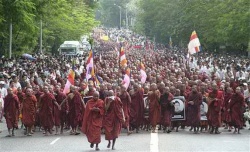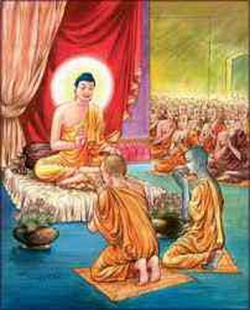Vipassana Nana's
Nana or insight which realizes this nature of mind and matter is called Namarupa-pariccheda-Nana. It is also called Ditthi-Visuddhi.
The cause of mind and matter is no other than mind and matter. It was true in the past, it is true in the present and it will be true in the future. Nana or insight which realizes this fact is called Paccayapariggahanana. It is also called Kankhavitarana Visuddhi.
Sammasana-nana
After seeing Anicca, Dukkha and Anatta nature of mind and matter, Nana or insight jumps to the conclusion that Anicca, Dukkha, Anatta nature must be inherent in mind and matter in the past and future also. This Nana or insight is called Sammasananana.
On proceeding further with the contemplation, it will be observed that all rupa and nama arise and pass away at every moment of contemplation. For this reason the phenomenal nature of their impermanence will be known and appreciated. This is "Anicca-sammasana-nana" (Insight into the impermanent nature of phenomena).
It will also be observed and perceived that the natural phenomena of rupa and nama are constantly taking place and that this arising and passing away of matter and mind have incessantly caused sufferings, and therefore, they are neither pleasant nor reliable, and are terribly miserable and distressing. This is "Dukkha-sammasana-nana" (Insight into ill-condition).
Realizing the fact that these conditioned things are happening on their own volition and that their phenomenal occurrences do not follow the dictates of one's own will, they are observed and perceived as neither "atta" nor "Self' but merely "anatta" (Not-self). This is "Anatta-sammasana-nana" (Insight into non-atta or non-self).
After having made an analytical observation and reflection on these facts with entire satisfaction, the disciple proceed with his contemplation as usual without further reflection. At this stage, he will clearly perceive the beginning of the arising of towards the sense-object at every moment of his contemplation. He will also perceive the coming to an end of this sensation which is completely severed. At this Juncture, there may arise many other strange happenings, such as
Udayabbhaya-nana
Nana or insight that perceives the beginning and end of an Arammana is called Udayabbayanana. It is also called Maggamaggananadassana-Visuddhi.
mental visions of brilliant or bright light
arising of rapturous feelings,
arising of feelings of calmness,
strong devotional feelings relating to Buddha and Dhamma
great enthusiasm to carry out the practice of meditation
joyful feelings
extremely rapid, clear and purified perception of sense-objects
the capability of practicing mindfulness without missing to note any sensation that needs be contemplated.
the capability to contemplate automatically without making particular effort.
feeling of subtle pleasure in the contemplation
The yogi (disciple) is so much encouraged and elated that he cannot remain mute and cannot help recounting his experiences. This is just an initial or immature stage of "Udayabbhaya-nana" and a misconceptions of "magganana"
After having come to this decision if the contemplation is carried on in continuity, those feelings of contentment and satisfaction and mental visions of light will gradually decrease, and the perception of the objects will become clearer and clearer with awareness. The gradual arising and dissolution of numerous phenomena with all their movements taking place at a snail pace, will be clearly perceived fragment by fragment, in the course of a single act of bending or stretching the arm or the leg or of taking a step, before it even reaches from one stage of a series of movement to another, that is, without reaching the end of a chain in the consecutive movements of the limb from one position to another. This knowledge is the mature form of Udayabbhayanana", flawlessly free from 'Upakkilesa'. (impurities).
Bhanga-nana
After being aware of the disappearance of an Arammana second mind is aware of the disappearance of the 1st mind. Nana or insight that is aware of these two steps is called Bhanga Nana
When this 'nana' has gained more strength, the perception of the phenomenal sense-objects becomes accelerated. Therefore, the end-vanishing of the sense feelings is more clearly manifested and becomes more noticeable than the beginning of their arising Then, all sense-objects would appear as if they have already vanished. Forms and shapes of hand, leg, head, body, etc., are no longer perceived and are found to be fading away followed by dissolution every time contemplation is made. It is also perceived with awareness that even the contemplating mind along with its objects of contemplation vanishes one after the other immediately in succession. This knowledge and awareness of the process of vanishing in pairs of the sense-object and the knowing mind at every moment of contemplation is called "Bhanga-nana" (Insight into the dissolution of things).
Baya-nana
Having perceived that both the knowing mind and the phenomenal sense-objects are constantly passing away, in the past, present and future, there arises the knowledge that they are really frightful. This knowledge is, however, viewed with pleasure. This is "Baya-nana" (Awareness of frightful condition)
Adinava-nana
Then there arises the realization of the fact that these psycho-physical phenomena so rapidly dissolving are undesirable being faulty and defective in nature. This is "Adinava-nana" (Insight into unsatisfactory condition)
Nibbida-nana
On proceeding with the contemplation, awareness of the unattractive and boring nature of things takes place. This is 'Nibbida-nana" (Insight into wearisome condition, a Nana that becomes totally disinterested in mind and matter.)
Muncitukamyata-nana
Then, knowledge or awareness also occurs looking forward to escape from the misery and sufferings brought about by those phenomena of arising and passing away of rupas and namas, and thinking at the same time that it would be better if these physical and mental phenomena cease to exist altogether. This knowledge is "Muccitu-kamyata-nana" (Knowledge or insight arising from desire to escape.
Patisankha-nana
At this stage as contemplation is carried on with most anxiousness for an escape (deliverance), a clear perception of 'anicca', 'dukkha' and 'anatta' would arise. In particular, the nature of dukkha, sufferings, may be perceived very convincingly. This is 'Patisankha nana" (Insight arising out of further contemplation; Nana or insight that regains the awareness of Anicca or Dukkha or Anatta nature of mind and matter).
Sankharupekkha-nana
When this 'Patisankha-nana' is fully strengthened, contemplation and awareness become automatic and proceed on its own like the machine of a clock. It proceeds contemplating on objects with equanimity,. i.e.., superficially taking notice of them, and avoiding to pursue the arising of good or bad sensations. It is so very delicate and gentle. Such contemplation may go on automatically with awareness as it gains momentum for one hour, two hours or three hours. Even though it may last so long, there will be no tiredness or exhaustion. The realization of the true nature of the objects of contemplation without exertion and without pursuing good or bad sensations in the course of the contemplation which lasts for a long time is "Sankha-rupekkha-nana" (Knowledge or insight arising from viewing things with equanimity; Nana or insight, that is indifferent to Arammana).
Anuloma-nana
While such realization is going on automatically, extremely fast and active knowledge reappears and his knowledge which advances with a big rush towards a noble path known as "Vutthana-magga is called "Vutthana-gamini vipassana-nana" (Insight leading to elevation).
That special knowledge appears with the realization that physical and mental phenomena which occur at the six sense-doors momentarily are impermanent, suffering and not-self (anatta). The knowledge that arises at the last moment is "Anuloma-nana" (Knowledge of adaptation) which consists of three 'javanas', impulse moments, called 'Parikamma' (preparation), 'Upacara' (approach) and 'Anuloma' (adaptation). Anulomanana transforms mind to become qualified to enter the threshold of Nibbana. This is the "Nana" that is gained in consonance or in harmony with the preceding eight " Vipassana-nana" and subsequent 'Magga-nana" (Knowledge of the Path)
After 'Anulomanana' there arises "Gotrabhu-nana" (Knowledge overmastering kinship) which grasps the sensation towards Nibbana where the miseries and sufferings connected with rupa and nama entirely cease. Gotrobhunana pushes mind across the threshold. As soon as mind crosses the threshold, it becomes aware of Nibbana. This is the knowledge which severs the lineage of 'Putthujjanas' (worldlings) and enters the lineage of the 'Ariyas' (Noble Ones)
Then, there arise "sotapatti Magga and Phala Nana" (Insight wisdom arising from the Noble Path of Stream-winning and its Fruition) which realises Nibbana. The 'Magganana' is called "Nana-dassana-visuddhi" (Purity of insight)
The moment of arising of the 'magga and Phala Nana' does not last even for a second. Then retrospective reflection of the peculiar experiences of the "Magga, Phala and Nibbana" takes place. This is 'Paccavakkhana-nana" (Insight of retrospection).
One who has acquired knowledge up to the stage of 'pacavakkhana-nana' seriatim to the procedure outlined above, is a "Sotapanna" (Stream-Winner).
References
1. "Purpose of Practising Kammatthana Meditation", by Mahasi Sayadaw, Buddha Sasana Nuggaha Organisation, Rangoon.
2. "How to become a real Buddhist", Department for the Promotion and Propagation of the Sasana, Ministry of Religious Affairs, Yangon, 1991.
3. "Buddhism: Theory and Practice", By U Maung Nu, Mahachulalongkorn Buddhist University, Bangkok, 1983.






